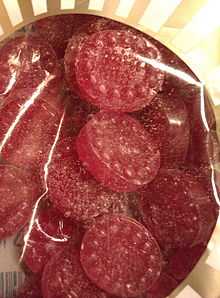Hard candy
| Hard candy | |
|---|---|
 | |
| Alternative names | Boiled sweet |
| Type | Confectionery |
| Main ingredients | Syrup (sucrose, glucose, or fructose) or isomalt, citric acid, food colouring, flavouring |
| Variations | Many (such as candy cane or lollipop) |
|
| |
A hard candy, or boiled sweet, is a sugar candy prepared from one or more sugar-based syrups that is boiled to a temperature of 160 °C (320 °F) to make candy. Among the many hard candy varieties are stick candy (such as the candy cane), lollipops, aniseed twists, and bêtises de Cambrai.
Hard candy is essentially 100% sugar by weight. Recipes for hard candy may use syrups of sucrose, glucose, fructose or other sugars. Sugar-free versions have also been created.
Once the syrup blend reaches the target temperature, the candy maker removes it from the heat source and may add citric acid, food dye, and some flavouring, such as a plant extract, essential oil, or flavorant. The syrup concoction, which is now very thick, can be poured into a mold or tray to cool. When the syrup is cool enough to handle, it can be folded, rolled, or molded into the shapes desired. After the boiled syrup cools, it is called hard candy, since it becomes stiff and brittle as it approaches room temperature.
Chemistry
Chemically, sugar candies are broadly divided into two groups: crystalline candies and amorphous candies.[1] Crystalline candies are not as hard as crystals of the mineral variety, but derive their name and their texture from their microscopically organized sugar structure, formed through a process of crystallization, which makes them easy to bite or cut into. Amorphous candies have a disorganized crystalline structure. Hard candies are non-crystalline, amorphous candies containing about 98% (or more) solid sugar.[2]
Medicinal use

Hard candies are historically associated with cough drops, both because sucking on sugar candy is comfortable for a sore throat, and also because many apothecaries used sugar candy to make their prescriptions more palatable to their customers.
Sugar-free
Hard candies and throat lozenges prepared without sugar employ isomalt as a sugar substitute, and are sweetened further by the addition of an artificial sweetener, such as aspartame, or a sugar alcohol, such as xylitol.[3]
See also
Confectioners of boiled sweets
- John Millar & Sons
- Jolly Rancher (now a division of The Hershey Company)
- Maxons Ltd, manufacturer of Black Bullets
- Public Displays of Confection manufacturers of Image Candy
Notes
- ↑ McWilliams, Margaret (2007). Nutrition and Dietetics' 2007 Edition. Rex Bookstore, Inc. pp. 177–184. ISBN 978-971-23-4738-2.
- ↑ NPCS (2013). Confectionery Products Handbook (Chocolate, Toffees, Chewing Gum & Sugar Free Confectionery). India: Asia Pacific Business Press. pp. 9–13.
- ↑ Edwards, W. P. (2000). The Science of Sugar Confectionery. Cambridge: Royal Society of Chemistry. ISBN 085404593-7. Retrieved 20 March 2014.
References
| Wikimedia Commons has media related to Hard candy. |
- "Temporary Metal Fences / Asphalt Shingles / Expanded Polystyrene Products / Hard Candies". How It's Made. Season 2. Episode 4. Science Channel. More than one of
|season=and|seriesno=specified (help) - Sherman, Bob. "Basic Hard Candy Making Instructions". Williston Park, New York: Bobby's Craft Boutique. Retrieved 20 March 2011.